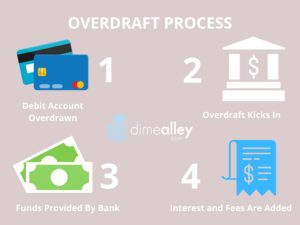What Is An Overdraft?
An overdraft occurs when a bank allows a customer to withdraw more cash than is in their account.
An overdraft acts as a line of credit from your bank and is called an overdraft because you have literally overdrawn from your account. When you enter an overdraft, you are using money that isn’t yours. Rather, you are using money that belongs to your bank, and therefore you will need to repay them, as with any other form of debt.
You could find yourself entering an overdraft when withdrawing from an ATM, making a purchase via your debit card, through issuing a check, an automatic bill payment / direct debit, among other possibilities. To avoid entering an overdraft, it is crucial that you remain up to date with how much you have in your account versus how much you are spending.
As with other loans, interest will be applied to most overdraft repayments. This interest will typically be expressed as an Annual Percentage Rate, making it easier to compare which banks’ overdrafts are more expensive to use.

Key Points:
- An overdraft is when your bank helps tide you over by providing you with credit when the funds in your account aren’t sufficient to cover your costs.
- There are two types of overdraft – arranged overdraft (authorized) and unarranged overdraft (unauthorized).
- The average overdraft fee is $33.58 which will be applied every time you enter your overdraft.
- You can rearrange your overdraft limit by contacting your bank
- If you repay your overdraft debt fully and on time, then your credit record won’t be impacted by you entering your overdraft
What is an Arranged Overdraft?
If you and your bank have agreed in advance that you will be entering your overdraft, then this is considered an ‘authorized’ or ‘arranged’ overdraft.
In these circumstances, you and your bank may arrive at an agreed overdraft limit, alongside an agreed repayment term. For example, if you approach your bank in advance and request an arranged overdraft, they may offer you a $500 overdraft to be repaid within six months.
In some cases, banks will offer customers a regular limit that is always available to them, as long as you reliably repay your debt.
What is an Unauthorized Overdraft?
Also known as an ‘unarranged’ overdraft, unauthorized overdrafts occur when you overdraw without agreeing it with your bank beforehand. An unauthorized overdraft also pertains to when you exceed the limit of an authorized overdraft, and are usually attached to higher fees than authorized overdrafts.
This can occur when you need to make a large payment that you didn’t anticipate, or when you mistook how much money you had in your account.

What are Overdraft Fees and How Much are They?
Overdraft fees are charged when you spend more than is in your account, and your bank provides the credit to cover your payments to prevent them from bouncing.
While fees will vary from bank to bank, 2021 saw overdraft charges hit an average of $33.58, a record high and an increase on last year’s average, which sat at $33.47, according to Bankrate. Most major banks’ rates sit at around this mark, including Bank of America and Union Bank.
While $33 or $34 may seem like a trivial sum, these charges can be pressed again and again if you enter your overdraft multiple times, amassing hundreds of dollars of fees.
How Can I Avoid Overdraft Fees?
Many banks offer $0 overdraft fees if you have a savings account linked to your checking account. By doing this, you alter how your overdraft works. Instead of your bank covering your costs itself, it uses your money, but from an alternative account.
Let’s take a look at an example of how this works. Let’s say you have $200 in your checking account but need to pay a car repair bill of $350 that cannot wait. When you put this transaction through, a regular overdraft would see the bank cover the $150 excess that your account is lacking. If, however, you have a linked account, the bank will automatically withdraw $150 from the savings account you have linked to make up the difference, rather than covering the cost themselves.
Because this costs the bank nothing, they are unlikely to impose any overdraft fees. This is a service offered (with a $0 fee!) by banks including Capitol One 360, KeyBank and Union Bank. While other banks may charge for this, this will cost around a modest $10, rather than the higher cost of entering a regular overdraft.
Does an Overdraft Hurt Your Credit?
An overdraft will not hurt your credit score as long as you pay it back fully and within the agreed time frame.
Because your bank account is your own money, your spending is not typically relayed to Credit Bureaus. Your overdraft only becomes relevant to them if you fail to repay your debts. Therefore, as long as you use your overdraft respectably, your credit record won’t be damaged.
Can You Give Me An Example Of An Overdraft?
Let’s say you have $100 in your checking account. You go to the supermarket and the items in your basket cost $200. You get to the checkout, present your card, and put the transaction through. It is at this point that your overdraft kicks in. Rather than your credit card company rejecting the payment due to insufficient funds, they allow it to go through, providing you with the $100 you need to pay for your groceries.
Now, you owe your bank $100. However, they may also apply an overdraft fee of around $35. So, you owe $135 in repayment, and there may also be interest (of around 15-40%) applied to the outstanding $100.
Can I Switch Banks If I’m Overdrawn?
Yes, in theory you can switch banks even if you are in your overdraft. This is as long as your credit record is respectable enough that you are approved by a new bank.
Most banks will offer a switching service, that will allow you to transfer your overdraft from one bank to another – so don’t think that switching will wipe away your debt!
However, if you have previously failed to repay your overdraft, a new bank may be hesitant to accept you as a client. Switching banks does not allow you to escape any poor credit history, and you will still need to pay back your overdraft.
Can I Increase My Overdraft?
Yes, in most cases you can increase your overdraft. You can apply to change your overdraft limit online, and if you have reliably repaid your overdrafts in the past, your bank is likely to approve you for an increased overdraft.
You can also reduce your overdraft limit if you wish to. Again, you can do this online with most banks, or you could contact them via phone, or visit an in-store branch.
Is an Overdraft More Expensive Than a Payday Loan?
Yes, sometimes! Overdraft fees hit a record high in 2021, making them increasingly more expensive, sometimes more so than payday loans.
With an average fee of $33.58 per overdraft entered, repeat users are encountering high costs which need to be repaid in a timely manner to avoid incurring damage to your credit record. For interest checking accounts, the average monthly fee for an overdraft is currently sitting at $16.35, another record-setting figure.
Payday loans cost borrowers around $30 per $100 borrowed, and sometimes significantly more. Therefore, there is a lot of disparity and there isn’t a yes or no answer as to which is more expensive.
Both are expensive and repayments are vital for each. You should carefully consider whether you can afford these forms of loans prior to using them.
